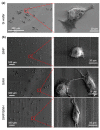Laser Interference Lithography-A Method for the Fabrication of Controlled Periodic Structures
- PMID: 37368248
- PMCID: PMC10301502
- DOI: 10.3390/nano13121818
Laser Interference Lithography-A Method for the Fabrication of Controlled Periodic Structures
Abstract
A microstructure determines macro functionality. A controlled periodic structure gives the surface specific functions such as controlled structural color, wettability, anti-icing/frosting, friction reduction, and hardness enhancement. Currently, there are a variety of controllable periodic structures that can be produced. Laser interference lithography (LIL) is a technique that allows for the simple, flexible, and rapid fabrication of high-resolution periodic structures over large areas without the use of masks. Different interference conditions can produce a wide range of light fields. When an LIL system is used to expose the substrate, a variety of periodic textured structures, such as periodic nanoparticles, dot arrays, hole arrays, and stripes, can be produced. The LIL technique can be used not only on flat substrates, but also on curved or partially curved substrates, taking advantage of the large depth of focus. This paper reviews the principles of LIL and discusses how the parameters, such as spatial angle, angle of incidence, wavelength, and polarization state, affect the interference light field. Applications of LIL for functional surface fabrication, such as anti-reflection, controlled structural color, surface-enhanced Raman scattering (SERS), friction reduction, superhydrophobicity, and biocellular modulation, are also presented. Finally, we present some of the challenges and problems in LIL and its applications.
Keywords: laser interference lithography; laser materials processing; micro/nanostructuring; periodic structure; surface functionalization.
Conflict of interest statement
The authors declare no conflict of interest.
Figures















References
-
- Bhushan B., Jung Y.C. Natural and biomimetic artificial surfaces for superhydrophobicity, self-cleaning, low adhesion, and drag reduction. Prog. Mater. Sci. 2011;56:1–108. doi: 10.1016/j.pmatsci.2010.04.003. - DOI
-
- Xia F., Jiang L. Bio-Inspired, Smart, Multiscale Interfacial Materials. Adv. Mater. 2008;20:2842–2858. doi: 10.1002/adma.200800836. - DOI
-
- Malshe A.P., Bapat S., Rajurkar K.P., Haitjema H. Bio-inspired textures for functional applications. CIRP Ann. 2018;67:627–650. doi: 10.1016/j.cirp.2018.05.001. - DOI
Publication types
Grants and funding
LinkOut - more resources
Full Text Sources
Miscellaneous

